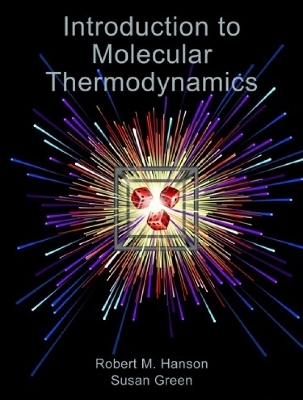
Introduction to Molecular Thermodynamics
University Science Books,U.S. (Verlag)
978-1-891389-49-8 (ISBN)
and the distribution of energy, this book takes students (and faculty!) on an
adventure into the inner workings of the molecular world like no other.
“I wish I had learned thermodynamics this way!” That’s what the authors hear all the time from instructors using Introduction to Molecular Thermodynamics. Starting with just a few basic principles of probability and the distribution of energy, the book takes students (and faculty!) on an adventure into the inner workings of the molecular world like no other. Made to fit into a standard second-semester of a traditional first-year chemistry course, or as a supplement for more advanced learners, the book takes the reader from probability to Gibbs energy and beyond, following a logical step-by-step progression of ideas, each just a slight expansion of the previous. Filled with examples ranging from casinos to lasers, from the “high energy bonds” of ATP to endangered coral reefs, Introduction to Molecular Thermodynamics hits the mark for students and faculty alike who have an interest in understanding the world around them in molecular terms.
Key Features
Develops students' intuition and quantitative confidence.
Designed to fit within the second semester of a traditional first-year chemistry course.
Includes chapter-ending summaries, problems and brain teasers.
Answers to selected problems appear at the back of the book.
Provides an assortment of helpful appendices, including Mathematical Tricks.
Features a robust Author Website that includes a PowerPoint Introduction, an online Interactive Guide to the Book, and much more.
ROBERT HANSON is a Professor of Chemistry at St. Olaf College, in Northfield, Minnesota, USA, where he has been teaching since 1986. Trained as an organic chemist with Gilbert Stork at Columbia University, USA, he shares a patent with 2001 Nobel Prize winner K.Barry Sharpless for the asymmetric epoxidation of allylic alcohols. His interest in thermodynamics goes back to early training at the California Institute of Technology, from which he got a B.S. degree in 1979. SUSAN GREEN has had the privilege of being both a student and a professor at St. Olaf College in Northfield, Minnesota, USA, where she was first introduced to the idea of teaching thermodynamics to first-year students. She trained as a physical chemist at the University of Minnesota, USA, studying the vibrational and electronic structure of small metal oxides as well as trying her hand at analytical chemistry.
1 Probability, Distributions, and Equilibrium
2 The Distribution of Energy
3 Energy Levels in Real Chemical Systems
4 Internal Energy (U) and the First Law
5 Bonding and Internal Energy
6 The Effect of Temperature on Equilibrium
7 Entropy (S) and the Second Law
8 The Effect of Pressure and Concentration on Entropy
9 Enthalpy (H) and the Surroundings
10 Gibbs Energy (G)
11 The Equilibrium Constant (K)
12 Applications of Gibbs Energy: Phase Changes
13 Applications of Gibbs Energy: Electrochemistry
APPENDIX A Symbols and Constants
APPENDIX B Mathematical Tricks
APPENDIX C Table of Standard Reduction Potentials
APPENDIX D Table of Standard Thermodynamic Data (25°C and 1 bar)
APPENDIX E Thermodynamic Data for the Evaporation of Liquid Water
Answers to Selected Exercises
| Erscheint lt. Verlag | 21.7.2008 |
|---|---|
| Verlagsort | Sausalito |
| Sprache | englisch |
| Maße | 203 x 260 mm |
| Gewicht | 820 g |
| Themenwelt | Naturwissenschaften ► Chemie ► Physikalische Chemie |
| Naturwissenschaften ► Physik / Astronomie ► Thermodynamik | |
| ISBN-10 | 1-891389-49-1 / 1891389491 |
| ISBN-13 | 978-1-891389-49-8 / 9781891389498 |
| Zustand | Neuware |
| Haben Sie eine Frage zum Produkt? |
aus dem Bereich



